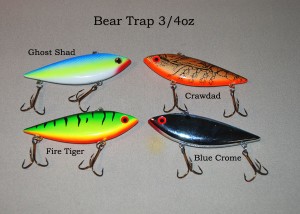By Chris Erwin
Cabin fever may not be a true affliction but for some of us, the symptoms are as real as any other sickness.
When the sun breaks through the clouds, I want to stand in the heat of it and think about the sunny days of summer. Every day we are getting closer to the birth of new flowers, the budding of new leaves and the earth turning that shade of green, signaling spring is truly here.
Last week we talked about the “jerkbait” and how it is already catching fish. This week we’re going to talk about the second bait you should make sure you have in your box this spring. It is the lipless crankbait. The lipless crankbait, much like the jerkbait, represents a group of baits that all work in a similar way. While they are many brand names, some of the most well-known ones are: The Rattle Trap, Cotton Cordell, Super Spot, Crème, and Mad Dad Minnow. These baits may look very much alike, but they all have little differences that make them effective on any given day.
This group of baits can be worked in many ways from vertical jigging to slow rolling, but for the spring we want to talk about fishing this bait on the “edges and ledges.” To be a clear for anyone who is learning, we are talking about fishing the edges of old weed beds, and the ledges where the water takes a sharp drop in depth.
Both Bass and Musky love this bait in the spring. If you are fishing known Musky water, you want to use a 1 oz. model. For Bass, the 3/8 oz. to ½ oz. baits are the most popular. Colors will very according to water clarity. Chrome and blue/chrome are known to be good clear water colors. However, fire-tiger and brightly colored patterns are often your best bet in stained or muddy water.

If your focus is Musky, you might want to add a steel leader to your rig. The first two things you need to be aware of when fishing this bait are: depth and speed control. If you find that the fish are deep, you will want to count the bait down on the cast before starting your retrieve. The speed of your retrieve will determine if the bait falls on the retrieve or rises. Once you catch a few fish, it will become clear if you want it on the rise or fall. This factor will determine the speed you need to use when fishing both edges and ledges.
The next most important factor while fishing this bait is boat position. I can’t stress enough how important this is. Always start by moving the boat parallel to the edge or ledge so that the bait stays in the strike zone for as much of the cast as possible. If you happen to be fishing ledges, like old roadbeds, you can start in the parallel position. Move the boat slowly as you fan cast until you are 90 degrees to the ledge, running your bait off the ledge. A pause as you come off the ledge can be effective at times and should be explored.
This group of baits is also very effective on schooling fish, such as White Bass and Hybrid Bass. The weight of this bait also makes it easy to cast long distances and it can be fished at any depth without modification, making it valuable bait and one that should earn room in your tackle box.
Editor’s Note: This piece first appeared in the Greater Ashland Beacon.



Be the first to comment